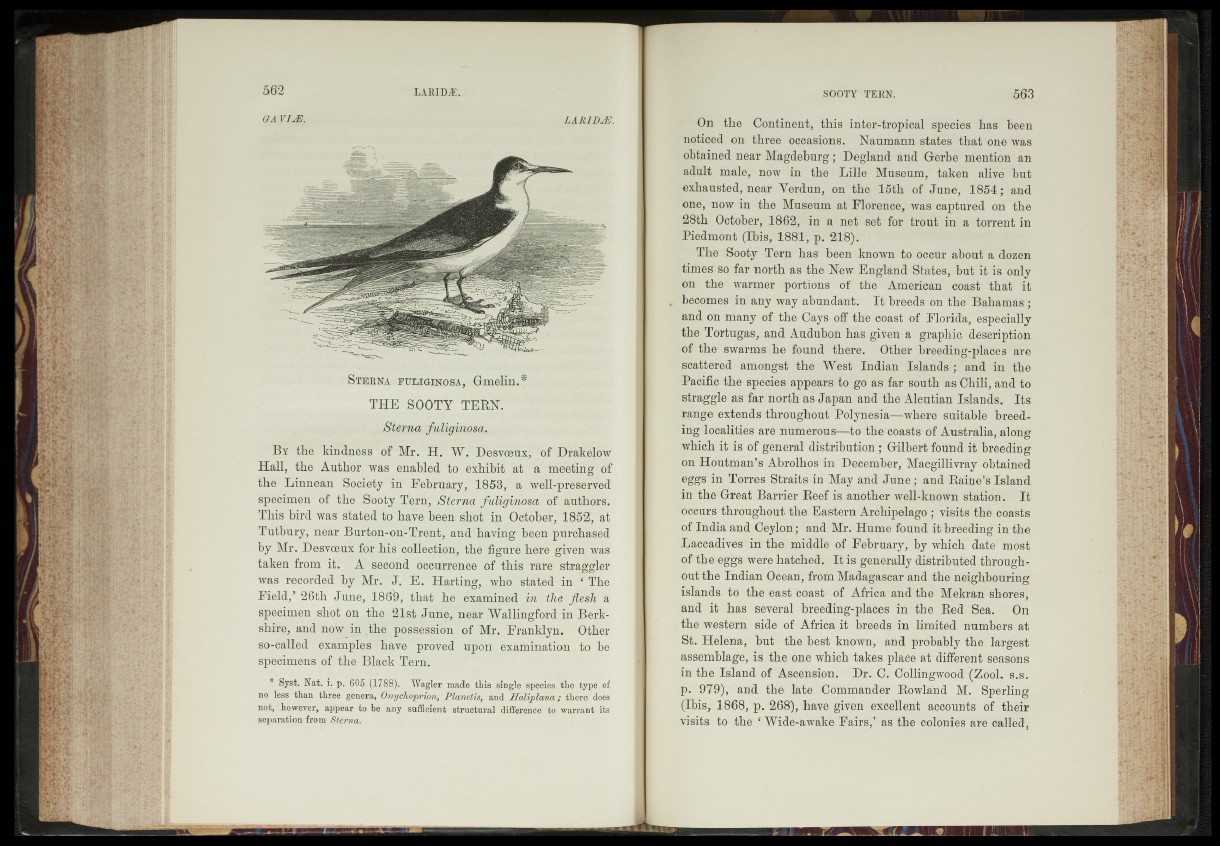
S t e r n a fu l ig jn o sa , Gmelin.*
THE SOOTY TEEN.
Sterna fuliginosa.
B y the H'ndnesS' of "Mr.- H. W/Nm^muxf ~of Brakelow
Hall, the Author was enabled to-Cxhibit at a meeting
the Linnean Society' in February, 1853, a well-preserved
specimen of the Sooty'Tern,' Sterna, JultgiWsa^&i authors.
This bird was stated to have bï,en shot in October, 1852, at
TutburyfnearBurton-on-Treht; and having been purchased
by Mr. Desvceuxfor his collection, -the'figure here* given' was
taken from it.1 ^second 'occurrencè o|Plhïs rare' stragglèr
was recorded by Mr. ^^B.'-Harting, who stated in “'The
Field,’ 26th Jpi^|186b, that _he .examined hjPll«B fiesM a
specimen shot on the, 21 at June^near Wafflhgford'in Berkshire,
and now_ ip of Mr. Franklyn. Ot’Ê'cr
so-called examples havé ‘proved upon examination * to be
specimens of the Black Tern." '
* Syst. Nat. i. p. G05 (17S|S) Edgier made this,single specie-) the type ot
i& less than three genera, C/nychojmon, Platifds, and Hgliplana; tfiere does
not, however, appear to’ be any suffioifent structural differenee"to'warrant its
separation from Ster-p,u.’-
On the Continent, Ibis in tér-tropical species has been
noticed-on three occasions. Naumann states ‘ that one was
.obtained near Magdeburg-;, Degland and Gerbe mention an
adult male, now in the Lille Museum, taken alive but
exhausted, near Verdun,-on the 15th o f June, 1854.; and
one, now in the Museum at Florence, was captured oh the
28th -October, 18-62, in a net set'for trout in a torrentin
Piedmont (Ibis, 188Trp. 218). ’
■^The. .Sooty Tern has been known to occur about a dézen
times so far north’ 'as* tfefe ISFew England'States, bu tltl's only
on the-, warmer ’portions ' óf ' the American^ coast 'that I t
Ibécomes in’any way abundant'^It breeds ot the Bahamas;
and on many of the Cays off the ■co&stVof Florida, especially
the Tortugas, and Audubon has given a graphic description,
Mr the swarms he found there. ‘ Other breeding-places are
Scattered amongst the'West Indian Jilted:^; and im'the
-Pacific the species appears f d -go as far- south as Chili, and to
straggle as far nolth as Japan and'!thé* Aleutian Islands. Its
.mnge extends throughout Polynesia—where suitable' breeding
localities are 'nlihaêrous—to the Coasts of Australia, along
which it is of general distribution ; Gilbert found it breeding
*4® Houtman’S^AbrolhtfS^in December, Macgilliv-ray obtained
'éggs feTorres Straits in May and June ; and Baine’s Island
in the'Great Barrier Reefis another well-known station: It
i||curS'throughout; the -Eastern Archipelago ; visits the coa'sts
©f India and Ceylon ; and-Mr.'Humé found it Breeding in the
^Laccadive's in the middle of February, by whiclT date" molt
of the'teggS were hatched. Ifëf& generally distributed through-
%utthe Indian Ocean, from Madagascar-and the neighbouring
islands to-the-east coast' bf Africa and the Mekran shores]
and it has several breeding-places in the Eed Sea. On
|fte western side of Africa it breeds in limited numbers at
St: Helena, but the best known, and probably the largest
assemblage, is the one which takes place'at different seasons
in the Island of Ascension. fcW-r&flJ Collingwood (Zóol.' s.s.
p . -97®)] and the late Commander'Rowlahd M. Sperling
(Ibis, 1868, p. 268), have’- given excellent accounts of their
visits to the £ Wide-awake Faiir-s,’ as the colonies'.are called,